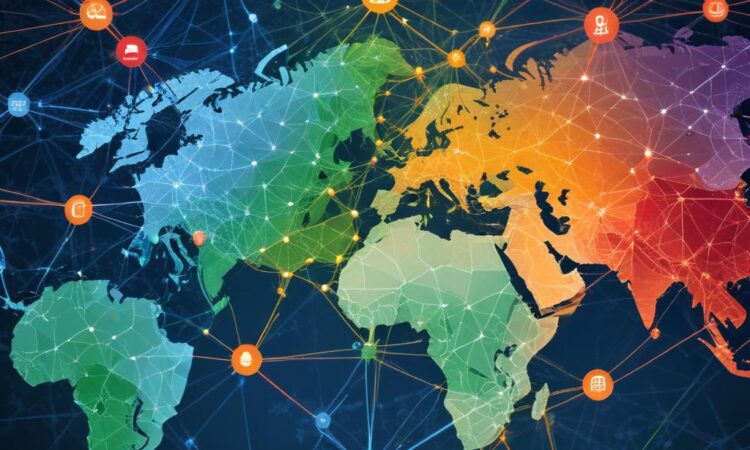Supply Chain Disruptions and Commodity Prices
While supply chain disruptions have eased somewhat, certain sectors still face bottlenecks, particularly in energy and raw materials. This continues to influence commodity prices, contributing to inflationary pressures. Recent reports highlight ongoing geopolitical instability and weather events as key factors.
The global economy remains deeply interconnected, and disruptions in one area can have cascading effects throughout the system. The initial shockwaves of the pandemic, while subsiding, have left a lasting impact on logistical networks, manufacturing processes, and consumer behavior. The recovery has been uneven, with some industries experiencing a relatively swift rebound while others grapple with persistent challenges.
One of the most significant ongoing issues is the energy sector. Geopolitical tensions, particularly the ongoing conflict in Ukraine, have drastically impacted energy supplies, leading to soaring prices for oil, natural gas, and electricity. This has a ripple effect across numerous industries, increasing production costs and impacting consumer affordability. The reliance on specific regions for critical energy resources highlights the vulnerability of global supply chains to geopolitical instability.
Similarly, the availability of raw materials remains a significant concern. Many industries depend on specific materials sourced from particular geographic locations. Disruptions in these supply lines, whether due to political unrest, natural disasters, or logistical bottlenecks, can lead to shortages and price increases. The automotive industry, for example, has been heavily impacted by shortages of semiconductors and other critical components, leading to production delays and increased vehicle prices.
Weather events continue to play a significant role in disrupting supply chains. Extreme weather patterns, including droughts, floods, and hurricanes, can damage infrastructure, disrupt transportation networks, and impact agricultural production. These events can cause widespread shortages of essential goods and drive up prices, exacerbating inflationary pressures. The increasing frequency and intensity of extreme weather events, linked to climate change, further exacerbate this challenge.
The impact of these disruptions extends beyond simply higher prices. Businesses face challenges in meeting consumer demand, leading to potential losses in market share and profitability. Consumers, in turn, experience higher costs of living, reduced purchasing power, and potential shortages of essential goods. The cumulative effect of these pressures can lead to economic instability and social unrest.
Addressing these challenges requires a multifaceted approach. Governments play a crucial role in fostering international cooperation, promoting investment in infrastructure, and implementing policies to mitigate the impact of extreme weather events. Businesses need to diversify their supply chains, invest in resilience planning, and adopt more sustainable practices. Consumers can contribute by supporting businesses that prioritize ethical and sustainable sourcing practices.
Looking ahead, the outlook for supply chains remains uncertain. While some improvements are expected, the underlying vulnerabilities remain. The ongoing geopolitical tensions, the impact of climate change, and the inherent complexities of global trade suggest that disruptions will likely continue to be a recurring feature of the global economy for the foreseeable future. Continuous monitoring, proactive planning, and collaborative efforts across governments, businesses, and consumers are crucial to mitigating the impact of these disruptions and building more resilient and sustainable supply chains.
The interconnectedness of global supply chains means that even seemingly isolated events can have far-reaching consequences. A drought in one region can impact agricultural production worldwide, affecting the availability of food and feed, while a port closure due to a natural disaster can disrupt the flow of goods across continents. This complex interplay of factors necessitates a comprehensive and adaptable approach to managing supply chain risks.
Furthermore, the increasing focus on sustainability and ethical sourcing adds another layer of complexity. Businesses are under growing pressure to ensure their supply chains are environmentally and socially responsible. This requires a shift towards more transparent and traceable supply chains, demanding greater collaboration and information sharing across the entire network.
In conclusion, while there have been some positive developments in easing supply chain disruptions, significant challenges persist. The interplay of geopolitical instability, extreme weather, and the inherent complexity of global trade continues to exert upward pressure on commodity prices and contribute to inflationary pressures. A proactive and collaborative approach is essential to build more resilient, sustainable, and adaptable supply chains for the future.
This requires a combination of short-term measures to address immediate bottlenecks and long-term strategies to enhance the overall resilience of global supply chains. Investing in infrastructure, diversifying sourcing, promoting technological innovation, and fostering international cooperation are all key elements in navigating the ongoing challenges and building a more robust and secure global economic system.
The path towards improved supply chain resilience is not without its hurdles. The need for global collaboration and the inherent uncertainties associated with geopolitical events and climate change present significant obstacles. However, through proactive planning, strategic investment, and a commitment to sustainable practices, it is possible to build a more resilient and equitable global economy, mitigating the impact of future disruptions and fostering greater stability and prosperity.
The complexity of global supply chains necessitates a continuous reassessment of risks and vulnerabilities. Regular monitoring, data-driven decision-making, and agile adaptation are crucial in navigating the dynamic landscape of global trade and ensuring the smooth flow of goods and services. This ongoing process of evaluation and improvement is essential to building more resilient and sustainable supply chains that can withstand future challenges.
Ultimately, the future of global supply chains depends on a collaborative effort involving governments, businesses, and consumers. By working together, we can build a more robust, resilient, and sustainable system that can meet the demands of a growing global economy while mitigating the risks associated with disruptions and promoting equitable access to essential goods and services.
The ongoing challenges highlight the critical need for continuous improvement and adaptation within the global supply chain network. Through strategic planning, technological innovation, and collaborative partnerships, we can strive towards a more resilient and sustainable future.
The information provided in this report is intended for informational purposes only and should not be considered as financial or investment advice.

